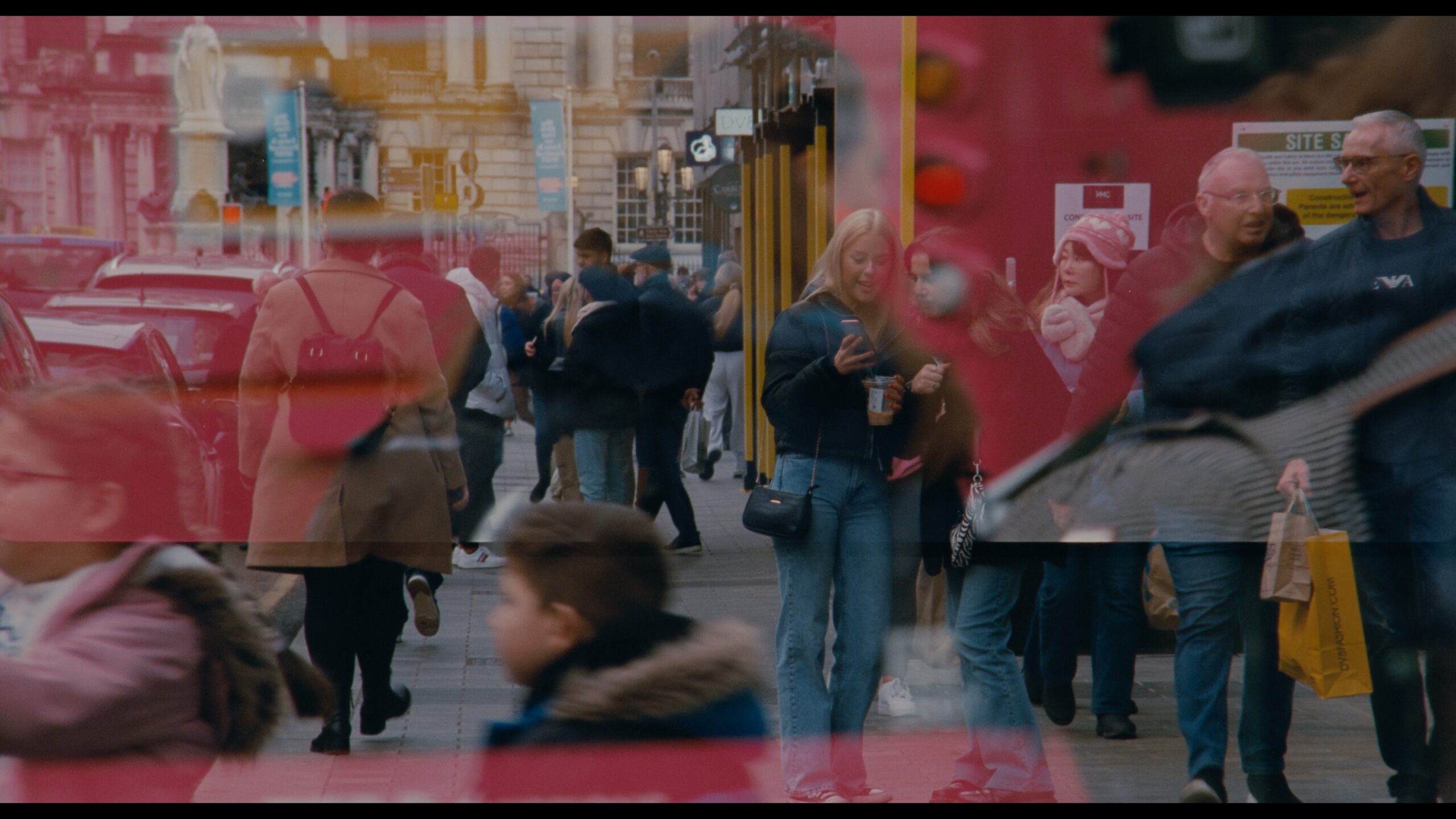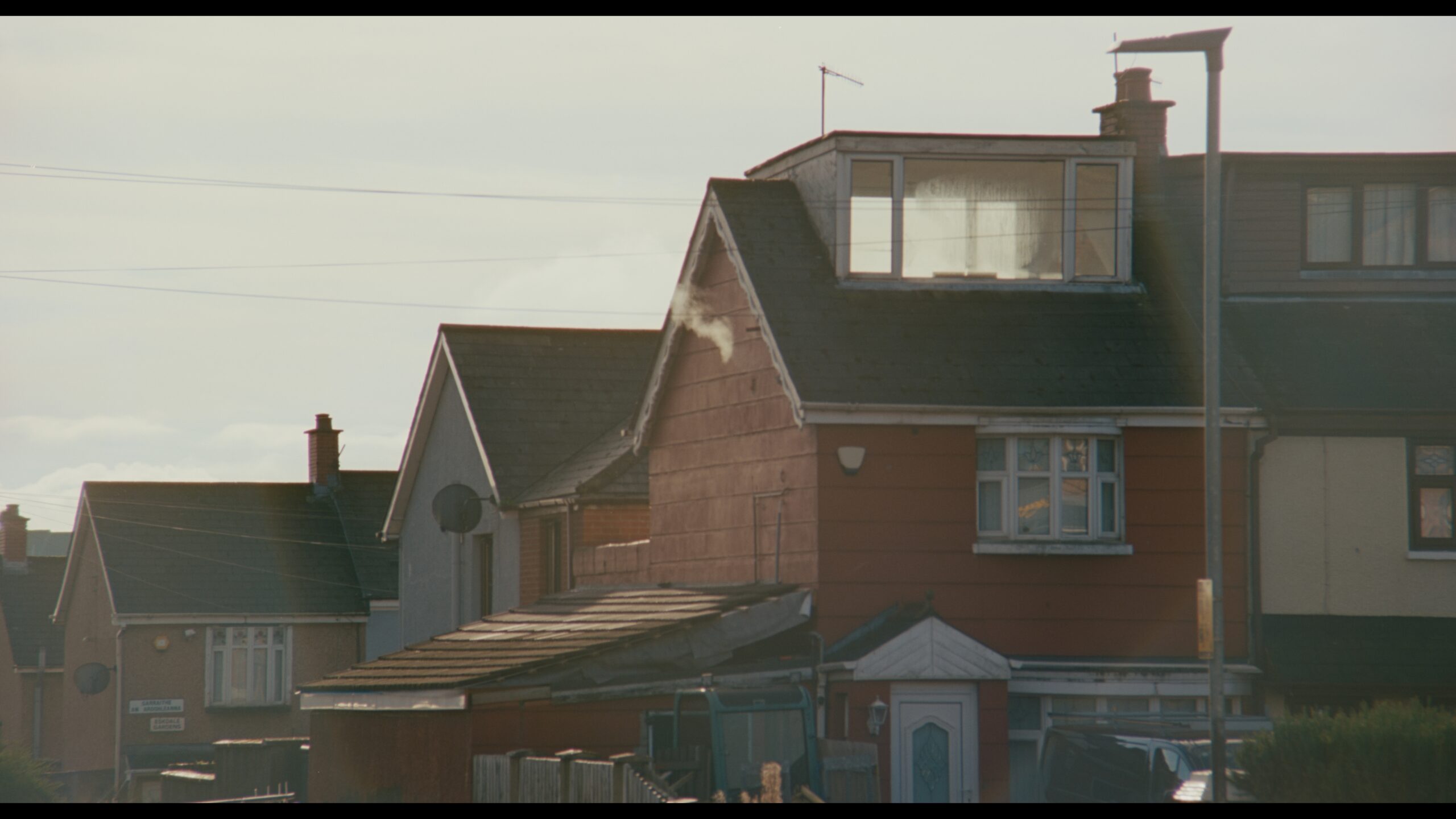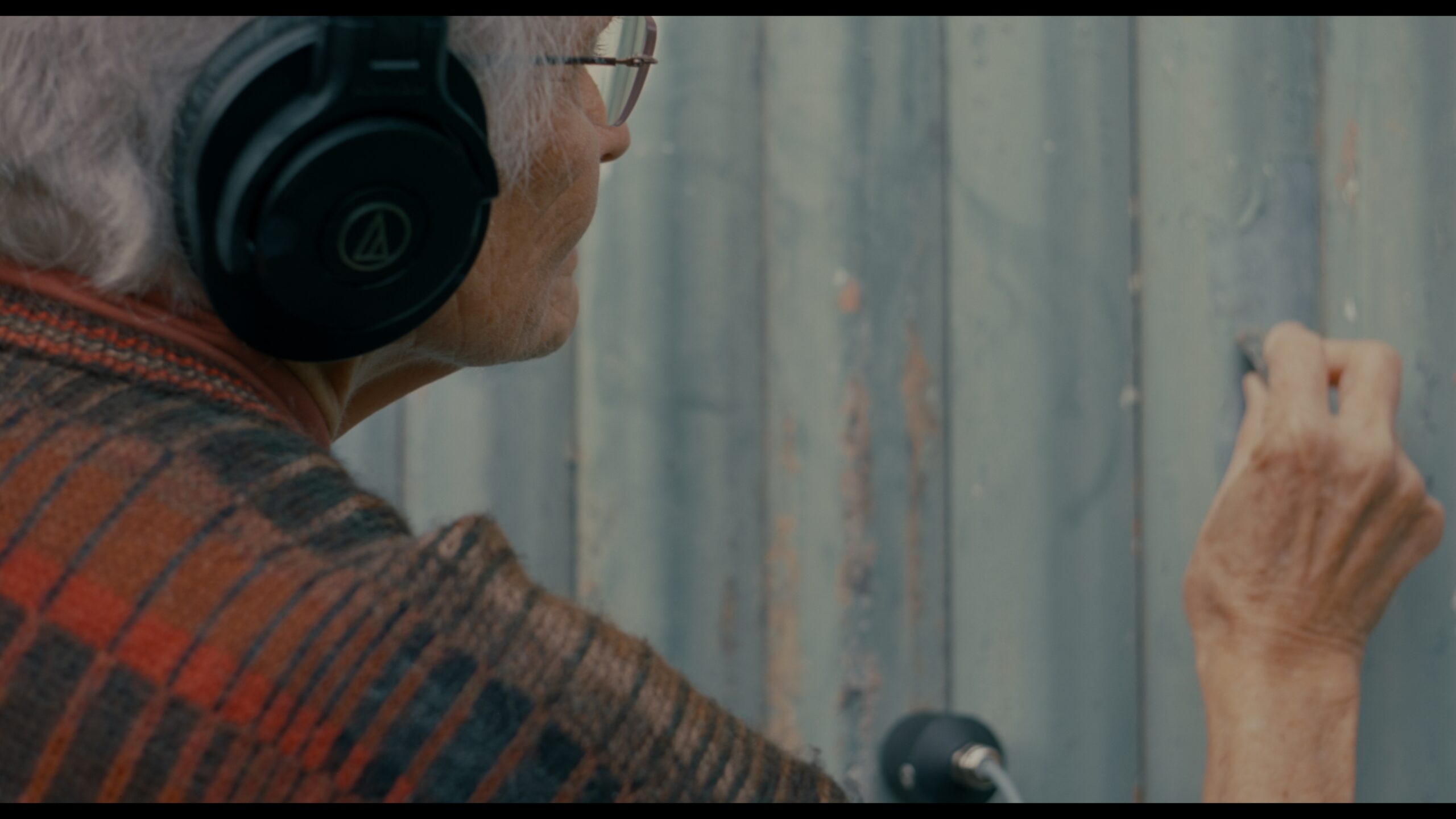
Sitting within a horseshoe theatre at The Queen’s Hall in Edinburgh, an ambient lilac-tinged light tinges the seats and centre stage. Amongst its seats a full house eagerly awaiting the start of History of the Present, an opera-film co-directed by Maria Fusco and Margaret Salmon with live improvisation from percussionist Angela Wai Nok Hui. Fusco grew up alongside the peacelines in Belfast, Northern Ireland, throughout the Troubles, and this piece purposefully premiered in conjunction with the 25th anniversary of The Good Friday Agreement.
Where to begin? It is hard to start by describing this event’s opening, which had such a visceral and non-linear beginning. Initially, somatic sounds pulsated through the theatre as a woman holds a microphone close to her mouth. The lights are still up, and the large film screen at the front remains blank, but I can see a series of instruments in the middle of the floor. I didn’t recognise many of them, and later found out they range between a thunder sheet, marimba, hi-hat, snare and field drum and kick bass drum, the ripple effects of the live performance reverberating through my body with each action.
“At the centre of this piece is women reclaiming space in History of the Present: the use of a borrowed tape recorder from Fusco’s childhood, the voice of her mother, is a reminder that the lives lived were real, every day, and continuous across generations and families.”
The lights drop. The screen turns, and the forty-five-minute film begins. “Could it be a bit louder?” Héloïse Werner says, in front of a white wall in a black cardigan. “Bit louder still,” she says. Closing her eyes and reopening them, she begins making repetitive noises of different speeds and variations. Tempos change, pauses come unexpectedly, her chest reclining and moving. Then, a quick breathing out. Then, a return to fast vocal sounds. Then hissing sounds. Four minutes in, we see footage of a road in Belfast, Werner’s vocal noises acting as an uneasy soundtrack to suburban scenes.
The title History of the Present, in part, signals the ongoingness of the traumatic experience of living through a civil war – the ‘aftermath’ of experience and poverty. The non-linearity of memory and bodily reactions, the unpredictable ways we live through and return to sites of the past. Yet the filming is not declarative, and nor does it spell out to the viewer how we are to find order and time amongst the spoken word and moving image. Instead, it shows how, quite literally, the body keeps the score across time and history and asks: How do women reclaim the past in the present?

In this way, each artistic choice has a deeply feminist politic at its heart. The footage of Belfast, specifically Ardoyne (the area Fusco grew up in), was taken between 2022 and 2023, and the film is made on a 35mm and SD video in the streets of Belfast, the Ulster Museum, and the Royal Opera House. The filming is both familiar and unfamiliar, mundane and specific – encapsulating the experience of everyday violence in the present. Semi-autobiographical, the merging of past and persistent traumas creates an uncanny amalgamation of life in Northern Ireland, albeit one the audience, for a moment, is submerged within.
The vocal work by Werner is both uncomfortable and necessary – integrated within the film as its own narrative. The operatic sounds are sublime while sometimes verging on panic, slipping between moments of anticipation and rest. Living on a peaceline, the exhaustion of being in survival mode is so elegantly crafted through these different creative forms in the piece. Werner’s disposition is almost a little nervous at points, and as a viewer, I feel empathy for her, a sense of her own bravery seeping through the boundary of the screen. Smoke ripples across the screen with a broken sound. The mourning is pertinent and boundless.
At times, the film is uncomfortable to watch, but it is through this affective encounter that the audience is asked to, for a moment, feel what might have historically been hidden from view. The camera is like a disembodied spectre, floating between the Werner and the physical world, sounds and vibrations. Predominantly situated against a blank wall, there is no distraction from her – we encounter the very real experience of how history is held in the body and can need to be expelled into the world.
“During the performance, I found myself wondering about my own notions and ideas about The Troubles, the absence of it from my substandard state school education in England, and the lack of discussion about its wider role in the United Kingdom.”
At the centre of this piece is women reclaiming space in History of the Present: the use of home video from Fusco’s childhood, the voice of her mother, is a reminder that the lives lived were real, every day, and continuous across generations and families. In a passage that recounts the abject horrors of violence on the body by Fusco, the everyday witnessing of others, the ongoing experience of what it meant to be a woman, whether a child, teenager, or adult, is described through segregation and bodily infiltration:
The sick smell of burning rubber tyres, 13-year-old girls, whenever they’re down the town being body-searched in makeshift shelters, their Tammy Girl bras being snapped at the back by soldiers who are two, three times their age, being told to keep their little titties growing for a good chewing one night. Older women being directed, by rifle, to walk under the handwritten sign, ‘sex-starved women this way’.
Here, the body is an object to be shunned, disciplined and vulnerable – under the guise of military operations and “protection”. Boundaries between safety and home are referenced through closeups of a locked door, a brick and steel wall, and the space and intimacy between the camera and strangers. The impending sense of present danger, despite the present being in the past present, is felt in the present tense. This is most acutely felt during Fusco’s segments of spoken word, which anchors the performance in collective grief: ‘We focus our eyes, losing depth perception. We’ve done this since we were youngsters, ‘ she says, later asking, ‘For alone, the brick is not a house. What keeps the house from falling down are the brick’s three cast holes.’ She answers her own question, stating they are ‘Sustained by mortar, Hardened by history’.

Sound itself demonstrates the overwhelming experience of shock and nearby terror of violence, but also the eeriness of silence. But in History of the Present, this silencing is rejected. At the centre of this piece are working-class women whose marginalised voices have not been given adequate space to speak. An oral history in its own right, this piece functions as a political stand against that very invisibility, an act of uncovering what demands to be said publicly. Field recordings are situated amongst a camera which goes in and out of view. Sound is what remains when language itself cannot explain great trauma.
During the performance, I found myself wondering about my own notions and ideas about The Troubles, the absence of it from my substandard state school education in England, and the lack of discussion about its wider role in the United Kingdom. Encountering The History of the Present felt bittersweet, presented through the brave, unwavering tapestry of women’s voices, talents, and experiences, but also prompting me to question my own consumption, or lack thereof, history. To reclaim this space is to, as Fusco advises, ‘take responsibility to give narrative to yourself’ – nobody else will when the media consistently manipulates a narrative. The piece makes visible what has gone unseen.
“The impending sense of present danger, despite the present being in the past present, is felt in the present tense.”
As Fusco demonstrates, class is not devoid of these experiences; social segregations between groups were directly marked by the peacelines and are carried with you wherever you go: ‘You’re always working class, even if your circumstances change’, Fusco says. Yet despite who you were or where you were, ‘All of us across Belfast, every street, every house, all of us, all of us watching in silence’. This silence, in the 45 minutes of History of the Present, is overturned, each sound, shot and flicker of trauma and recounting at a time.
Written by Hatty Nestor






